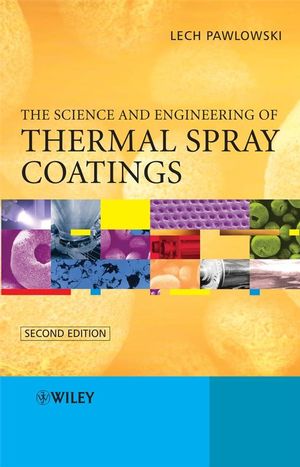The Science and Engineering of Thermal Spray Coatings, 2nd EditionISBN: 978-0-471-49049-4
Hardcover
656 pages
May 2008
 This is a Print-on-Demand title. It will be printed specifically to fill your order. Please allow an additional 10-15 days delivery time. The book is not returnable.
|
||||||
Preface to the First Edition.
Acronyms, Abbreviations and Symbols.
1 Materials Used for Spraying.
1.1 Methods of Powders Production.
1.1.1 Atomization.
1.1.2 Sintering or Fusion.
1.1.3 Spray Drying (Agglomeration).
1.1.4 Cladding.
1.1.5 Mechanical Alloying (Mechanofusion).
1.1.6 Self-propagating High-temperature Synthesis (SHS).
1.1.7 Other Methods.
1.2 Methods of Powders Characterization.
1.2.1 Grain Size.
1.2.2 Chemical and Phase Composition.
1.2.3 Internal and External Morphology.
1.2.4 High-temperature Behaviour.
1.2.5 Apparent Density and Flowability.
1.3 Feeding, Transport and Injection of Powders.
1.3.1 Powder Feeders.
1.3.2 Transport of Powders.
1.3.3 Injection of Powders.
References.
2 Pre-Spray Treatment.
2.1 Introduction.
2.2 Surface Cleaning.
2.3 Substrate Shaping.
2.4 Surface Activation.
2.5 Masking.
References.
3 Thermal Spraying Techniques.
3.1 Introduction.
3.2 Flame Spraying (FS).
3.2.1 History.
3.2.2 Principles.
3.2.3 Process Parameters.
3.2.4 Coating Properties.
3.3 Atmospheric Plasma Spraying (APS).
3.3.1 History.
3.3.2 Principles.
3.3.3 Process Parameters.
3.3.4 Coating Properties.
3.4 Arc Spraying (AS).
3.4.1 Principles.
3.4.2 Process Parameters.
3.4.3 Coating Properties.
3.5 Detonation-Gun Spraying (D-GUN).
3.5.1 History.
3.5.2 Principles.
3.5.3 Process Parameters.
3.5.4 Coating Properties.
3.6 High-Velocity Oxy-Fuel (HVOF) Spraying.
3.6.1 History.
3.6.2 Principles.
3.6.3 Process Parameters.
3.6.4 Coating Properties.
3.7 Vacuum Plasma Spraying (VPS).
3.7.1 History.
3.7.2 Principles.
3.7.3 Process Parameters.
3.7.4 Coating Properties.
3.8 Controlled-Atmosphere Plasma Spraying (CAPS).
3.8.1 History.
3.8.2 Principles.
3.8.3 Process Parameters.
3.8.4 Coating Properties.
3.9 Cold-Gas Spraying Method (CGSM).
3.9.1 History.
3.9.2 Principles.
3.9.3 Process Parameters.
3.9.4 Coating Properties.
3.10 New Developments in Thermal Spray Techniques.
References.
4 Post-Spray Treatment.
4.1 Heat Treatment.
4.1.1 Electromagnetic Treatment.
4.1.2 Furnace Treatment.
4.1.3 Hot Isostatic Pressing (HIP).
4.1.4 Combustion Flame Re-melting.
4.2 Impregnation.
4.2.1 Inorganic Sealants.
4.2.2 Organic Sealants.
4.3 Finishing.
4.3.1 Grinding.
4.3.2 Polishing and Lapping.
References.
5 Physics and Chemistry of Thermal Spraying.
5.1 Jets and Flames.
5.1.1 Properties of Jets and Flames.
5.2 Momentum Transfer between Jets or Flames and Sprayed Particles.
5.2.1 Theoretical Description.
5.2.2 Experimental Determination of Sprayed Particles’ Velocities.
5.2.3 Examples of Experimental Determination of Particles Velocities.
5.3 Heat Transfer between Jets or Flames and Sprayed Particles.
5.3.1 Theoretical Description.
5.3.2 Methods of Particles’ Temperature Measurements.
5.4 Chemical Modification at Flight of Sprayed Particles.
References.
6 Coating Build-Up.
6.1 Impact of Particles.
6.1.1 Particle Deformation.
6.1.2 Particle Temperature at Impact.
6.1.3 Nucleation, Solidification and Crystal Growth.
6.1.4 Mechanisms of Adhesion.
6.2 Coating Growth.
6.2.1 Mechanism of Coating Growth.
6.2.2 Temperature of Coatings at Spraying.
6.2.3 Generation of Thermal Stresses at Spraying.
6.2.4 Coatings Surfaces.
6.3 Microstructure of the Coatings.
6.3.1 Crystal Phase Composition.
6.3.2 Coatings’ Inhomogeneity.
6.3.3 Final Microstructure of Sprayed Coatings.
6.4 Thermally Sprayed Composites.
6.4.1 Classification of Sprayed Composites.
6.4.2 Composite Coating Manufacturing.
References.
7 Methods of Coatings’ Characterization.
7.1 Methods of Microstructure Characterization.
7.1.1 Methods of Chemical Analysis.
7.1.2 Crystallographic Analyses.
7.1.3 Microstructure Analyses.
7.1.4 Other Applied Methods.
7.2 Mechanical Properties of Coatings.
7.2.1 Adhesion Determination.
7.2.2 Hardness and Microhardness.
7.2.3 Elastic Moduli, Strength and Ductility.
7.2.4 Properties Related to Mechanics of Coating Fracture.
7.2.5 Friction and Wear.
7.2.6 Residual Stresses.
7.3 Physical Properties of Coatings.
7.3.1 Thickness, Porosity and Density.
7.3.2 Thermophysical Properties.
7.3.3 Thermal Shock Resistance.
7.4 Electrical Properties of Coatings.
7.4.1 Electrical Conductivity.
7.4.2 Properties of Dielectrics.
7.4.3 Electron Emission from Surfaces.
7.5 Magnetic Properties of Coatings.
7.6 Chemical Properties of Coatings.
7.6.1 Aqueous Corrosion.
7.6.2 Hot-gas Corrosion.
7.7 Characterization of Coatings’ Quality.
7.7.1 Acoustical Methods.
7.7.2 Thermal Methods.
References.
8 Properties of Coatings.
8.1 Design of Experiments.
8.2 Mechanical Properties.
8.2.1 Hardness and Microhardness.
8.2.2 Tensile Adhesion Strength.
8.2.3 Elastic Moduli, Strengths and Fracture Toughness.
8.2.4 Friction and Wear.
8.3 Thermophysical Properties.
8.3.1 Thermal Conductivity and Diffusivity.
8.3.2 Specific Heat.
8.3.3 Thermal Expansion.
8.3.4 Emissivity.
8.3.5 Thermal Shock Resistance.
8.4 Electric Properties.
8.4.1 Properties of Conductors.
8.4.2 Properties of Resistors.
8.4.3 Properties of Dielectrics.
8.4.4 Electric Field Emitters.
8.4.5 Properties of Superconductors.
8.5 Magnetic Properties.
8.5.1 Soft Magnets.
8.5.2 Hard Magnets.
8.6 Optical Properties.
8.6.1 Decorative Coatings.
8.6.2 Optically Functional Coatings.
8.7 Corrosion Resistance.
8.7.1 Aqueous Corrosion.
8.7.2 Hot-medium Corrosion.
References.
9 Applications of Coatings.
9.1 Aeronautical and Space Industries.
9.1.1 Aero-engines.
9.1.2 Landing-gear Components.
9.1.3 Rocket Thrust-chamber Liners.
9.2 Agroalimentary Industry.
9.3 Automobile Industry.
9.4 Ceramics Industry.
9.4.1 Free-standing Samples.
9.4.2 Brick–Clay Extruders.
9.4.3 Crucibles to Melt Oxide Ceramics.
9.4.4 Ceramic Membranes.
9.5 Chemical Industry.
9.5.1 Photocatalytic Surfaces.
9.5.2 Tools in Petrol Search Installations.
9.5.3 Vessels in Chemical Refineries.
9.5.4 Gas-well Tubing.
9.5.5 Polymeric Coatings on Pipeline Components.
9.5.6 Ozonizer Tubes.
9.6 Civil Engineering.
9.7 Decorative Coatings.
9.8 Electronics Industry.
9.8.1 Heaters.
9.8.2 Sources for Sputtering.
9.8.3 Substrates for Hybrid Microelectronics.
9.8.4 Capacitor Electrodes.
9.8.5 Conductor Paths for Hybrid Electronics.
9.8.6 Microwave Integrated Circuits.
9.9 Energy Generation and Transport.
9.9.1 Solid-oxide Fuel Cell (SOFCs).
9.9.2 Thermopile Devices for Thermoelectric Generators.
9.9.3 Boilers in Power-generation Plants.
9.9.4 Stationary Gas Turbines.
9.9.5 Hydropower Stations.
9.9.6 MHD Generators.
9.10 Iron and Steel Industries.
9.10.1 Continuous Annealing Line (CAL).
9.10.2 Continuous Galvanizing Section.
9.10.3 Stave Cooling Pipes.
9.11 Machine Building Industry.
9.12 Medicine.
9.13 Mining Industry.
9.14 Non-ferrous Metal Industry.
9.14.1 Hot-extrusion Dies.
9.14.2 Protective Coatings against Liquid Copper.
9.14.3 Protective Coatings against Liquid Zirconium.
9.15 Nuclear Industry.
9.15.1 Components of Tokamak Device.
9.15.2 Magnetic-fusion Energy Device.
9.16 Paper Industry.
9.16.1 Dryers.
9.16.2 Gloss Calender Rolls.
9.16.3 Tubing in Boilers.
9.17 Printing and Packaging Industries.
9.17.1 Corona Rolls.
9.17.2 Anilox Rolls.
9.18 Shipbuiding and Naval Industries.
9.18.1 Marine Gas-turbine Engines.
9.18.2 Steam Valve Stems.
9.18.3 Non-skid Helicopter Flight Deck.
References.
Index.



